
* In the postwar period, the Soviet Union began to acquire military helicopters, with Red Army machines obtained from the OKB (experimental design bureau) led by Mikhail Mil, and Red Navy machines obtained from the OKB led by Nikolai Kamov. Kamov focused on helicopters with a coaxial rotor system, featuring dual three-bladed rotors on a common shaft, rotating in opposite directions, a compact configuration handy for shipboard use. This document provides a history and description of Kamov's naval helicopters -- Ka-15, Ka-25, and Ka-27, plus their derivatives -- as well as the Ka-26 light civil utility helicopter, and its derivatives.
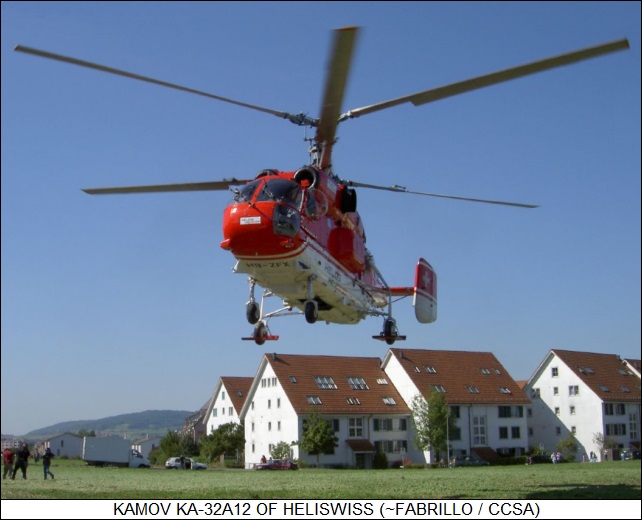
* Nikolai Ilyich Kamov, born in Siberia and once a locomotive engineer, acquired experience in rotary-wing aircraft by designing autogyros in the 1930s -- and in fact, helped Nikolai Skrzhinskiy build the very first Soviet autogyro, the "KaSkr-1", which first flew in September 1929. The two men were assisted by Mikhail Mil; Kamov and Mil would eventually become the men who built the Soviet Union's helicopters.
All three were assigned to the Soviet Central Aero-Hydrodynamic Institute, (TsAGI in its Russian acronym), leading to an improved autogyro, the "2-EA". Kamov used this experience to found his own OKB, leading to refined autogyros designated as "A-4" through "A-15", flown in the 1930s. None entered mass production, though a few did see service in the war against the Nazis.
Kamov's autogyro OKB was disbanded in 1943. Following the end of hostilities, Kamov developed an experimental single-seat ultralight helicopter, the "Ka-8" -- he called it a "vozdushniye motorsiklo (flying motorcycle)" -- which featured a "coaxial" rotor system, where twin three-bladed rotors spun in opposite directions on the same shaft. The Kamov OKB would favor the coaxial system in most of its subsequent rotorcraft. The scheme has a number of advantages, such as a small "footprint" convenient for shipboard use, and no diversion of power to a tail rotor that does not contribute to lift. On the minus side, it's complicated and suffers from relatively high drag, limiting top forward speed.
Three Ka-8s were built, the first flying in 1947. The Ka-8, like many early experimental helicopters, was a simple tubular steel framework with no fuselage, weighing about 180 kilograms (400 pounds) empty. It used a two-cylinder BMW motorcycle engine, and seems to have been seriously underpowered. All images of it show it with twin floats, suggesting they were standard kit.
However, the Ka-8 seemed promising enough to lead to the 1948 resurrection of Kamov's OKB, which developed the "Ka-10", similar to the Ka-8 but with a flat-four engine providing 40 kW (55 HP) and a revised dynamic system. It was first flown in 1949, being used by the Red Navy in small quantities as an observation platform; it assigned the reporting name of "Hat" by NATO. A dozen were built as the "Ka-10M", with twin tailfins instead of one.
* The Ka-10 led to a long relationship between Kamov and the AVMF, the Red Navy air arm, with Kamov developing a more useful, if still modest, helicopter, the "Ka-15", for that service. It retained the coaxial rotor configuration, but had a proper fuselage, two-seat side-by-side cockpit, and wheels instead of landing skids. The Ka-15 first flew in 1952, going into service with the Soviet Navy and Merchant Marine in 1955. The Ka-15 was assigned the NATO reporting name of "Hen".
___________________________________________________________________
KAMOV KA-15 "HEN":
___________________________________________________________________
rotor diameter:
9.96 meters (32 feet 8 inches)
fuselage length:
6.26 meters (20 feet 5 inches)
height:
3.35 meters (11 feet)
empty weight:
990 kilograms (2,180 pounds)
max loaded weight:
1,410 kilograms (3,110 pounds)
maximum speed:
150 KPH (95 MPH / 80 KT)
service ceiling:
3,000 meters (9,850 feet)
range:
390 kilometers (240 MI / 210 NMI)
___________________________________________________________________
The Ka-15 was a cute little machine that suggested a leafhopper. It was constructed mostly of aircraft aluminum alloy in a "pod & boom" configuration, with a tubby fuselage with a tailboom, ending in a tail with twin tailfins, tacked on to the upper rear. It was powered by an Ivchenko AI-14V nine-cylinder air-cooled radial piston engine, providing 195 kW (260 HP) for take-off; it seems later production had the supercharged AI-14VF radial with 210 kW (280 HP).
The wheels were in four-point configuration, with two small castoring wheels forward, and two large wheels with brakes and shock absorbers aft; apparently floats could be fitted as an option. The Ka-15 had rear-sliding doors on each side of the cockpit. It seems some Ka-15s were kitted up for antisubmarine warfare (ASW) -- but it is hard to believe it was taken very seriously in that role, since it had little load capacity. A civilianized version, the "Ka-15M", was also built, being used for crop spraying and for medical evacuation, with a stretcher fitted externally on each side. Sources mention a dual-control trainer variant, the "UKa-15", as well, but specifics are unclear.
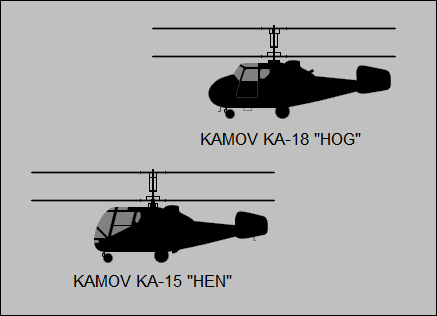
The Ka-15 established the baseline for following Kamov helicopter designs: all-metal construction, coaxial rotor system with three-bladed rotors, and quadricycle landing gear. A four-seat version of the Ka-15, the "Ka-18", first flew in 1957; it had, of course, a stretched fuselage, the AI-14VF engine being standard, and longer tailfins. It was assigned the unflattering NATO reporting name of "Hog". About 200 were built, most being operated by Aeroflot, the Soviet state airline -- nominally for civil uses, but Aeroflot was always at the call of the military. It doesn't appear that either the Ka-15 or the Ka-18 were exported in any numbers.
BACK_TO_TOP* Kamov's next-generation helicopter, the "Ka-20", began development in the late 1950s, being publicly unveiled at the Tushino-Moscow air show in 1961. The Ka-20 was in the form of an ASW helicopter; it clearly followed in the path of the Ka-15/18, featuring the coaxial rotor and four-point landing gear arrangement.
However, the Ka-20 was well bigger, being powered by two Glushenkyov GTD-3 turboshaft engines, providing 670 kW (900 HP) each, mounted on the top of the fuselage -- these engines being derived from the TVD-10 turboprop developed for the Antonov An-28 transport. Fuel tanks were under the cabin floor. The Ka-20 had rearward-sliding crew doors on each side of the cockpit, and a large sliding door on the left rear fuselage. The helicopter featured a triple-fin tail, a chin radome, and carried twin dummy air-to-surface missiles. It was given the reporting name of "Harp" by NATO.
* The Ka-20 was really just a demonstrator without combat capability, the basis for what would become the standard Soviet naval helicopter, the "Ka-25" -- first observed in public at the Paris Air Show in 1967, to be assigned the NATO reporting name "Hormone". It is actually somewhat unclear if there ever really was a "Ka-20"; certainly there was a prototype that got the name "Harp", but some sources hint the Ka-20 designation was a Soviet cover or a Western fiction.
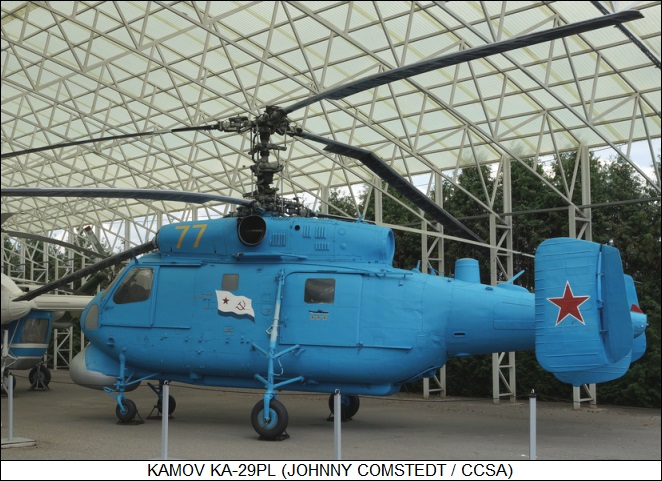
In any case, the baseline Ka-25, designate "Ka-25PL" (in some sources, "Ka-25BSh") AKA NATO "Hormone-A", was a straightforward refinement of the Ka-20, the two being similar enough to be confused at a casual glance. It was powered by twin GTD-3F engines, it seems production versions of the GTD-3, with hot-air inlet de-icing; later machines had GTD-3M engines, with 735 kW (985 SHP) each. The Ka-25PL featured corrosion protection and was fitted with full operational kit:
Each of the landing gear assemblies could be fitted with an inflatable flotation pack for ditching at sea; auxiliary fuel tanks could also be attached to each side of the forward fuselage. One distinctive recognition feature was that the Ka-20's tailfins were of rounded "guitar pick" configuration, while the Ka-25's were more rectangular.
___________________________________________________________________
KAMOV KA-25 "HORMONE-A":
___________________________________________________________________
rotor diameter:
15.74 meters (51 feet 8 inches)
fuselage length:
9.75 meters (32 feet)
height:
5.37 meters (17 feet 8 inches)
empty weight:
4,765 kilograms (10,505 pounds)
max loaded weight:
7,500 kilograms (16,535 pounds)
maximum speed:
210 KPH (130 MPH / 115 KT)
service ceiling:
3,350 meters (11,000 feet)
range:
400 kilometers (250 MI / 215 NMI)
___________________________________________________________________
The rotor system featured alcohol de-icing, hydraulic control, automatic hydraulic folding, and a nitrogen pressure system to detect cracks. The Ka-25 had a large set of access doors for maintenance, with the engine bay doors hefty enough to be used as work platforms. The Ka-25 primarily operated off KIEV-class guided-missile cruisers.
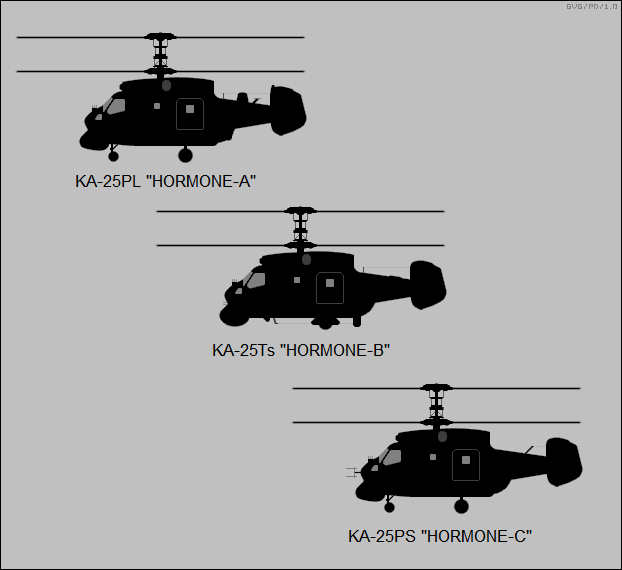
Two other variants were produced as well:
Sources mention a "Ka-25BShZ" minesweeping variant, with eight made, possibly by conversion from the Ka-25PL. A single "Ka-25K" demonstrator was displayed at the Paris air show in 1967, this being a civil utility transport / flying crane variant, with no combat kit, a slightly longer nose, and the nose radome replaced by a rear-facing gondola for a crane operator. It doesn't appear the Ka-25 was ever operationally used in civil service. There was also a proposal for an armed assault transport variant, designation given as "Ka-25F", that was never built. The last Ka-25s rolled off the assembly line in 1975, after completion of a total of 460 examples. Operators included, along with the USSR and post-Soviet states, Bulgaria, India, Syria, and Vietnam.
BACK_TO_TOP* Nikolai Kamov died in 1973, with Sergei V. Mikheyev taking over direction of the Kamov OKB. Under his leadership, the bureau went on to develop a bigger and more sophisticated series of naval helicopters to follow up the Ka-25 Hormone, which was successful but seen as lacking in power. Work on the "Ka-27" had actually begun in 1969; the first flight of a prototype was on 24 December 1973, with introduction to service in 1982. It was assigned the NATO reporting name of "Helix".
The Ka-27 was of similar general configuration to the Ka-25, with a coaxial rotor system, twin turboshaft engines, quadricycle landing gear, and even a similar footprint. It was, however, a substantially more capable machine, driven by Klimov / Isotov TV3-117V engines with 1,635 kW (2,190 SHP) each, giving it more than twice as much power for an increment of about quarter more empty weight; it also featured a much boxier fuselage -- reminiscent of a small bus -- with greater internal volume. Other refinements included an auxiliary power unit (APU) turbine for ground power; bigger fuel supply; an improved rotor system; more use of advanced materials such as titanium and composites; and a modernized autopilot coupled to a stability augmentation system to simplify keeping in place on hover. Avionics systems were generally updated.
The Ka-27 had a sliding rear door on the left, along with the sliding crew doors on each side of the cockpit. It dropped the middle tailfin of the Ka-25, giving it a twin-fin tail. Rectangular auxiliary fuel tanks could be scabbed onto the upper sides of the fuselage. The rotor blades, windscreen, and engine inlets were all electrothermally de-iced.
The initial production variant, the "Ka-27PL" AKA NATO "Helix-A", was a basic ASW platform, the sensor suite including Osminog (Octopus) search radar in an undernose radome; sonobuoys; dipping sonar, stowed behind doors at the rear of the main fuselage; and an ESM locator. Countermeasures systems were apparently added later. It could carry four homing torpedoes or guided ASW bombs in a belly weapons bay. The Ka-27PL normally had a crew of three, including pilot and navigator up front, with a sensor operator behind them. The lower hull was sealed to keep the helicopter afloat after ditching.
___________________________________________________________________
KAMOV KA-27 "HELIX-A":
___________________________________________________________________
rotor diameter:
15.9 meters (52 feet 2 inches)
fuselage length:
11.3 meters (37 feet 1 inch)
height:
5.4 meters (17 feet 8 inches)
empty weight:
6,100 kilograms (13,450 pounds)
max loaded weight:
12,600 kilograms (27,780 pounds)
maximum speed:
250 KPH (155 MPH / 135 KT)
service ceiling:
5,000 meters (16,400 feet)
range, max fuel:
800 kilometers (500 MI / 430 NMI)
___________________________________________________________________
There was also the "Ka-27PS", NATO "Helix-D", which was a simplified derivative for SAR. It was stripped of most combat kit except for radar and ESM; it was fitted with a rescue winch installed in the cargo door and floodlights alongside the nose; it could drop inflatable dinghys from the weapons bay. Unlike the Ka-27PL, it usually flew with inflatable flotation gear -- stowed in a rectangular pack on each side of the fuselage.
An export version of the Ka-27PL, featuring a detuned operational suite and an extra fuel tank scabbed onto each side of the fuselage, was designated "Ka-28". Export users included Algeria, China, India, South Korea, Syria, and Vietnam; a handful were not exported, being used for training. Ka-28s still remain in Russian service -- as does the Ka-27, with 22 upgraded to "Ka-27M" configuration, featuring Phazotron FHA radar, and a digital mission system. 46 are to be upgraded in all.
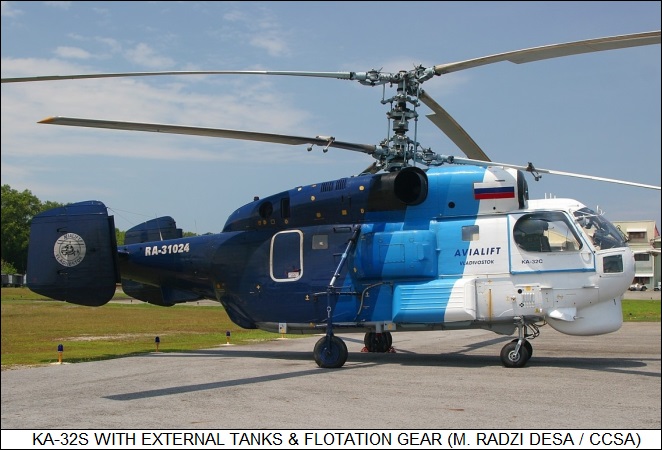
* The "Ka-32" (NATO "Helix-C") was a multi-role derivative of the Ka-27 for both civil and military use. The baseline "Ka-32T" was a pure utility transport, primarily for hauling cargo internally or on a sling, oriented towards replenishment of ships and offshore platforms, the most distinctive recognition feature being lack of a nose radome. The initial production version was the "Ka-32A", a civil utility variant -- leading to a number of subvariants, including:
The "Ka-32S" featured Osminog radar and other avionics systems for operations in foul / Arctic weather, along with a rescue hoist; it was intended for shipboard replenishment, ice reconnaissance, and SAR. The "Ka-32T" was a heli-liner, with sixteen passenger seats, again primarily for maritime applications; both the Ka-32S and Ka-32T were designated "Helix-C" by NATO. There was also a "Ka-32K" flying crane version, with an extensible gondola for a crane operator under the nose.
The Ka-32 has been operated by civil organizations in Brazil, Canada, Japan, Portugal, and Switzerland. The type has a good reputation for its utility, sturdiness, and reliability. South Korea is a major operator of the type, having obtained 46 from Russia as part of a 1995 deal to pay off Russia's debts to South Korea. The last of these were delivered in 2005, with seven going to the Republic of Korea Air Force (ROKAF), eight to the Coast Guard, the rest to the Forest Service. The ROKAF machines received avionics upgrades from Israeli Aerospace Industries before delivery.
The Kamov organization is now part of the "Russian Helicopters" group, along with the Mil helicopters organization. Russian Helicopters is offering a "Ka-32A11M" update for existing Ka-32 users; the upgrade includes a glass cockpit, improved engines, and new firefighting system. The engine update feature Klimov VK-2500PC-02 turboshafts, replacing TV3-117 turboshafts, with full-authority digital engine control, antisurge control, greater lift capacity, and most significantly greater time between overhauls. First redeliveries are expected in 2022.
* Following the introduction of the Ka-27, Kamov developed an assault transport derivative, the "Ka-29TB", which was introduced to service in 1985 and first noticed by NATO in 1987, to be given the reporting name of "Helix-B". It retained the same general configuration as the Ka-27, including TV3-117V turboshafts, but it was a substantial modification, most notably featuring a new wider forward fuselage, with three-across seating for pilot, navigator, and gunner; the Ka-29TB could be easily distinguished from the Ka-27 because the Ka-29's windshield had three flat panels, while the Ka-27's had two curved panels.
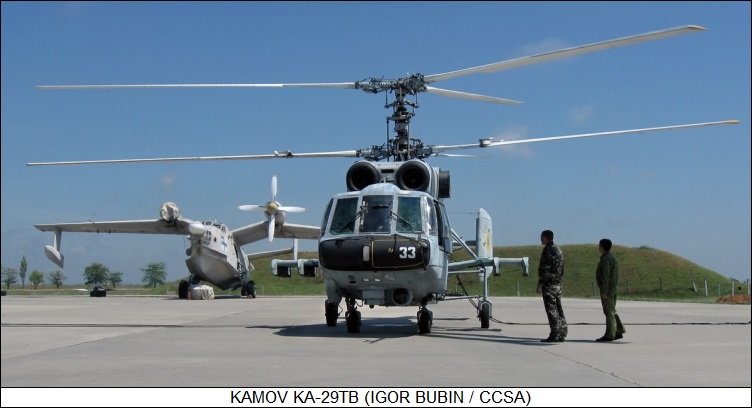
Other distinct features of the Ka-29TB were a prominent air data boom on the left side of the nose; a four-barrel Gatling-type 7.62-millimeter (0.30-caliber) machine gun in the lower right nose, with a link collector beneath it; and two struts for weapons carriage, typically four 57-millimeter or 80-millimeter unguided rocket pods, but also unguided bombs and guided antitank missiles, with a targeting pod built under the forward left fuselage. The weapons struts prevented the Ka-29TB from carrying flotation gear or external tanks.
Other features were a split rear door that hinged open top and bottom, an ESM antenna, and a countermeasures suite -- including a "disco light" heat-seeking missile jammer and chaff-flare dispensers. The Russian Ka-29 fleet fell into dilapidation after the fall of the USSR, but 20 were eventually refurbished, and continue in service.
* There was talk of a "Ka-33" civil derivative of the Ka-29TB, but it didn't happen. However, a radar airborne early warning (AEW) derivative was built as the "Ka-31", originally "Ka-29RLD", with initial flight of a test airframe in 1987, followed by a proper prototype three years later. It had the same basic airframe, but a large rotating radar antenna that could be hinged up for stowage under the fuselage. Its fuselage was wide all the way to the back, and there were no passenger doors, with the crew doors behind the cockpit changed to split configuration, the lower half featuring an airstair.
The landing gear tucked up to give the "E-801E Oko (Eye)" search radar a clear field of view. The rectangular radar antenna folded up underneath the fuselage when not in use. The Oko radar was sophisticated, capable of detecting up to 200 targets at once, while tracking 20 to 40 of them. A secure datalink could download data on targets being tracked.
The Indian Navy obtained an initial batch of nine Ka-31s, with service entry in 2003. The Ka-31s were run through an upgrade program a decade later, with five more ordered at that time, for a total of 14; ten more were ordered in 2020, for a total of 24. China obtained nine, with deliveries in 2010:2012. The Russian Navy has obtained two, designated "Ka-31R". There is also a battlefield surveillance variant, the "Ka-31SV", but details are scarce; rumor has it that the type went into service in 2015.
There was talk of a civilian "Ka-33" derivative of the Ka-29 as well, but it didn't happen, the Ka-32 presumably being perfectly adequate for civil use. In addition, from 1990 the Kamov organization worked on a modernized follow-on to the Ka-27/32, the "Ka-40", but the project was canceled in 1998.
BACK_TO_TOP* In 1965, the Kamov OKB showed off a prototype of the Ka-26 "Hoodlum-A", which was built for civil service, particularly agricultural applications. It was something of a direct descendant of the Ka-15/Ka-18 utility helicopters, featuring a coaxial rotor system, quadricycle landing gear, and twin tailfins -- though the tail assembly was fitted to a double boom. The Ka-26 had fiberglass rotor blades and twin M-14V-26 9-cylinder air-cooled radial engines, one in a pod fitted to each side of the machine and providing 240 kW (325 HP) each. Piston engines were used to reduce cost of manufacture and operation, at some loss in performance: the Ka-26 was seen as underpowered. However, the Ka-26 still had three times the payload capacity of the Ka-15.
___________________________________________________________________
KAMOV KA-26 "HOODLUM-A":
___________________________________________________________________
rotor diameter:
13 meters (42 feet 8 inches)
fuselage length:
7.75 meters (25 feet 5 inches)
height:
4.05 meters (13 feet 4 inches)
empty weight:
1,950 kilograms (4,300 pounds)
max loaded weight:
3,250 kilograms (7,165 pounds)
maximum speed:
170 KPH (105 MPH / 90 KT)
service ceiling:
3,000 meters (9,850 feet)
hover ceiling (in ground effect):
1,300 meters (4,265 feet)
hover ceiling (out of ground effect):
800 meters (2,625 feet)
range, no tanks:
400 kilometers (250 MI / 215 NMI)
___________________________________________________________________
The Ka-26 featured a "modular" configuration; it didn't have a fuselage as such, simply a cockpit, with rear-sliding doors on each side. An appropriate mission module was fitted up behind the cockpit, between the main gears, as per mission requirement. There was a module for six passengers, with dual bench seats, convertible to cargo hauling; medical evacuation, the module featuring two stretchers, plus seats for two sitting patients and a medical attendant; and crop spraying, with wide sprayer bars to each side. A flatbed could also be fitted; sling loads could be hauled without a module.
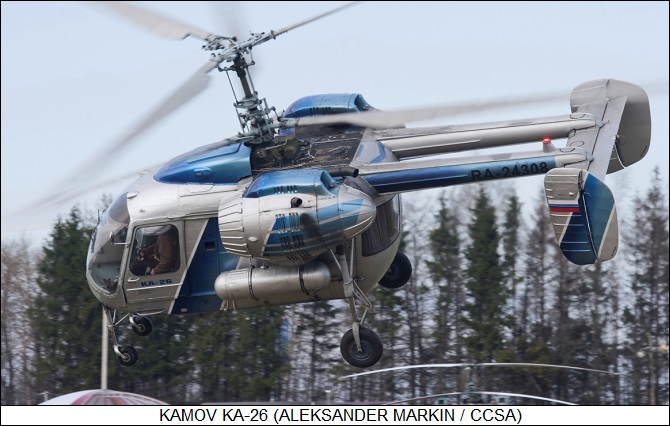
The Ka-26 proved a flexible "jack of all trades", being useful for utility and medical use, crop spraying, ice reconnaissance for civil vessels, and so on; it was too light for serious military use, however. The Ka-26 was one of the few modular flying machines to be successful, with a total of 816 Hoodlum-As built to end of production in 1977. The machine was exported in some numbers to Mongolia and a number of Warsaw Pact states.
Incidentally, as a tribute to the popularity of the Ka-26, in 2019 Moldovan authorities raided a clandestine workshop where illegal Ka-26 "clones" were being built, with ten found in production at the time. It is not clear if they were true copies, or just look-alike knock-offs. There's obviously an elaborate story behind this, but it's hard to say what it is.
* A "Ka-126 Hoodlum-B" was developed by IAR in Romania, it seems with design backup from the Kamov organization, being first flown in 1986. It was much like the Ka-26, but was powered by a single 540 kW (720 SHP) TVD-100 turboshaft engine on top of the fuselage, the engine pods being deleted; it also had an improved rotor and fuel system. Two prototypes and 15 production machines were built. A "Ka-128" was built for the export market, featuring a single 540 kW (720 SHP) Turbomeca Arriel 1D1 turboshaft and Bendix King avionics, but did not enter production.
However, the Kamov organization went on to develop "Ka-226", with twin 315 kW (420 SHP) Rolls-Royce / Allison 250-C20B turboshafts, mounted beneath the rotor system, not in pods; an updated rotor system; a heavily rebuilt cockpit with a longer nose; reprofiled tailfins, and modernized avionics, varying as per customer spec. Engine inlets were de-iced by hot air, the rotors and pitot tube were electrically deiced, with an alcohol de-icing system being used for the windscreen.
Avionics were updated; nose radar appears to be standard, with accessories such as an imaging turret, searchlight, or loudspeaker available as an option for police / border guard service and the like. An external tank could be fitted to each side. The Ka-226 retained the modular concept of the original Ka-26.
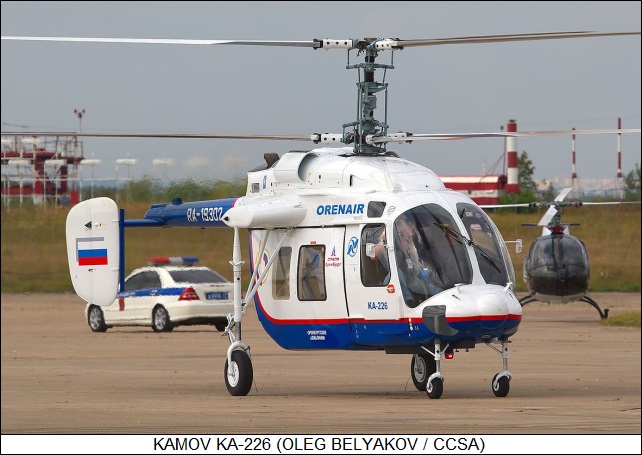
Initial flight of a Ka-226 prototype was in 1997, with the type ordered into production in 2004, beginning with a batch of 30 for the Russian Emergencies Ministry, which had driven development of the machine, and for the GAZPROM energy organization. The turboshaft powerplants gave the Ka-226 much better load and "hot & high" capability than the Ka-26, with service ceiling doubled and payload capacity increased by about 50%. The Ka-226 was assigned the NATO reporting name of "Hoodlum-C", though the Kamov organization calls it the "Sergei". A number of variations have been built or are on offer:
Total sales of the Ka-226 have been modest so far, only in the dozens. However, in 2016 a deal was signed with Hindustan Aerospace LTD of India for the assembly of about 200 Ka-226T rotorcraft. 60 will be provided by Russia, with 140 built by the Russian-Indian joint venture Indo-Russian Helicopters LTD. It is not clear when deliveries will start.
Work is now proceeding on a new "Light Multirole Helicopter" or "Lyogkiy Mnogotselevoy Vertolyot (LMV)", currently envisioned as in a size category smaller than the Ka-226, but with the Kamov coaxial rotor configuration. No specifics are available as of yet.
BACK_TO_TOP* Sources include:
A number of volumes of JANE'S ALL THE WORLD'S AIRCRAFT and the online Wikipedia was consulted as well.
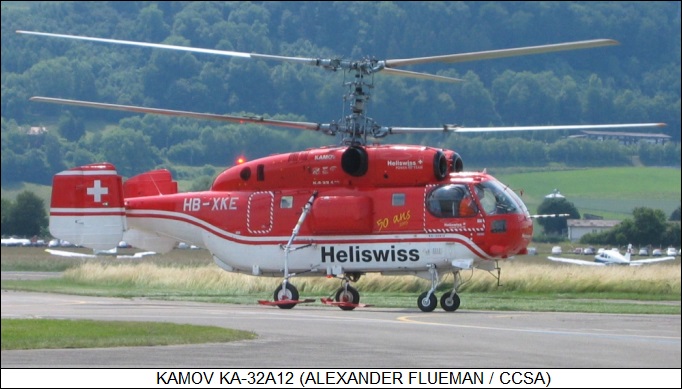
* Revision history:
v1.0.0 / 01 jun 14 v1.0.1 / 01 may 16 / Miscellaneous tweaks, review & polish. v1.0.2 / 01 apr 18 / India Ka-226s. v1.0.3 / 01 feb 20 / South Korean Ka-32s. v1.0.4 / 01 dec 21 / More on Ka-31s. v1.0.5 / 01 nov 23 / Review & polish.BACK_TO_TOP
